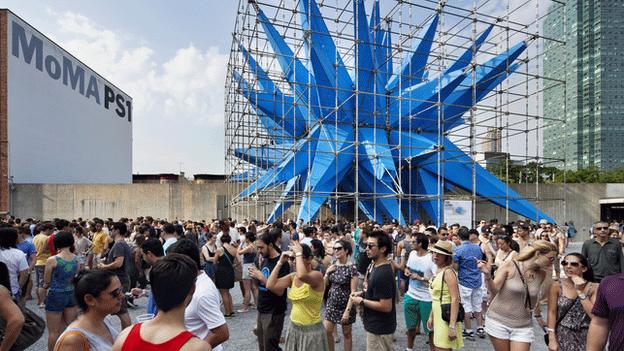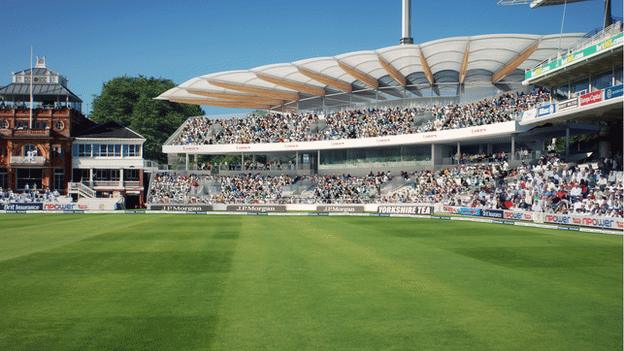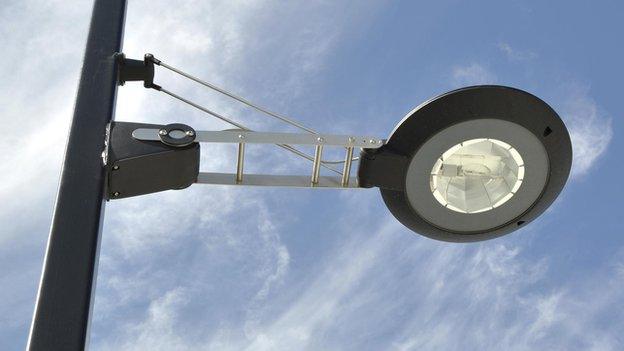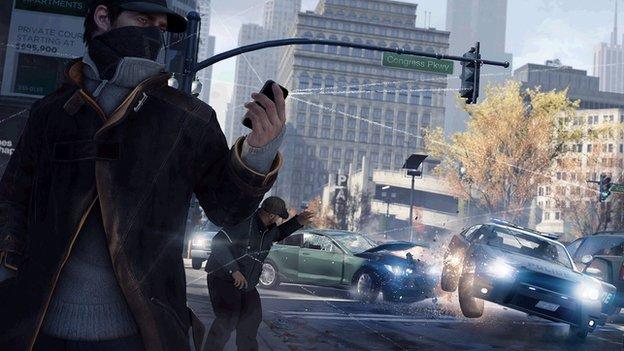Tomorrow's cities: The zoo where the humans are enclosed
- Published

The zoo offers a new way to see animals
The 21st Century is going to be marked by global urbanisation - by 2050, more than 70% of the world's population will live in cities.
New buildings will help define our future cities, but what do people want from them?
A recent survey from design company Sasaki asked people from six different US cities what they loved and hated about their urban environment.
It revealed a passion for old buildings - 57% of those surveyed looked at old buildings when walking down the street, compared with 15% who admired skyscrapers. Only 17% wanted more shiny, iconic buildings.
The BBC spoke to a series of architects and technologists about some of the more unusual buildings that might populate our future cities. None are quite what you might expect.
The zoo where the humans are enclosed

The new concept zoo
Bjarke Ingels has been commissioned to transform the Givskud Zoo in Denmark. He envisages some radical changes.
This zoo, still at the concept stage, was based on a philosophy of having only social animals.
A lot of people associate zoos with a lonesome tiger encaged in a small box, going nuts from boredom and claustrophobia., And I think when you have a social zoo, you can actually have a big group of animals living together in a habitat that resembles their normal habitat.
That sounded like an interesting starting point because it means that as a visitor you'd find yourself way outnumbered by the animals and not the other way around.
Zoos used to be really important for science and education, when people couldn't travel.
Now you have film, television and inexpensive air fares that allow a lot of people to actually see animals for themselves.
So part of the role of the zoo has disappeared.
Hopefully, Zootopia can be a really exciting contribution to the zoo experience - maybe one that makes it more interactive.
The zoo's ambition was to try to be a place where visitors don't notice the barriers between them and the animals.
'Pragmatic utopian'
So you're at this tipping point between the feeling of intimacy and the need for safety and security.
Some of the barriers we can incorporate in the water - for instance, by making sure that the boats stay on the side that is too deep for the animals to cross.
There are all kinds of other landscape tricks to make various types of barriers.
The main challenge, of course, is to really design the zoo in a way that the enclosure is still there, it's just not visible.
We also want to eliminate all traces of man-made architecture - no round African huts or Chinese pagodas.
Without this romantic, nostalgic, vernacular architecture, we can integrate the architecture into the landscape so that any blatant evidence of human presence is gone. Like camouflage.
As architects, we create the framework for the life we want to live.
As life evolves, so should our cities and buildings. And if they don't fit with the way we want to live our lives, it is not only possible but even our responsibility to make sure we change the city and make our physical world a bit more like our dreams.
I call it the "pragmatic utopian" approach - the contrast between a practical approach to reality as it exists and the utopian idea of trying to achieve a perfect world at the same time.
The house that wants to be liked

Wendy - a cantankerous building that was far from perfect
Marc Kushner, co-founder of Architizer, an online catalogue of architectural projects, wants buildings that can be a bit more human.
Buildings of the future will be smarter and more efficient.
They will be controlled by our smartphones and built by drones and 3D printers - but none of that will matter unless the public falls in love with architecture, because only then will they appreciate and demand better buildings.
When my architect firm won the MoMA/PS1 Young Architects Prize in 2012, we tried to create a building that elicited an emotional connection from people. We gave it a personality. We called her Wendy.
Wendy, a summer installation, was a cantankerous character that was far from perfect.
She leaked water from water misters, she was built from temporary scaffolding, her stairs were steep, and her giant fans blew out gusts of air (disturbing well coifed hipsters).
It was in her imperfections that Wendy became loveable.
Wendy would shoot out water from a water cannon, and then doused visitors would turn around and say: "Oh, Wendy!" They tweeted at her and Instagrammed with her. She was their summer pal.
Wendy's massive surface area, over 5,000 sq ft (465 sq m), was coated with titanium nano-particles that essentially sucked pollution out of the air - activated by sunlight, when CO2 adhered to the surface and was washed away as a neutral element by rain water.
Wendy's skin took the equivalent of 250 cars off the road.
Advancing technology means that buildings can do nearly anything we ask them to do - like proactively create better air in our cities.
We will build great cities when architects design sympathetic buildings that treat end-users like friends, rather than inert masses.
Architects want the public to love their buildings, perhaps the first step is for their buildings to start loving those same people.
Smart materials

The new Warner Stand at Lord's cricket ground will have a roof built with aerogel
Michael Trousdell, an associate at consulting firm Arup, thinks the future will bring smarter materials and buildings that users can control.
In the 1960s, construction of the Sydney Opera House was made possible by computer-powered structural design. Most buildings today are built out of computer-designed smart combinations of steel, cement and rock.
As we make greater technological and socioeconomic advances, however, even smarter things are inevitable.
Our recent adoption of smartphones embodies what we can expect - more control and more choice.
The latest trends suggest smarter buildings will deliver more sophisticated user-control and "healthier" internal environments while also reducing environmental impact.
Forward-thinking building owners, such as Google, are driving this next wave of innovation.

The company's recently built office in Amsterdam is a great example - combining environmental aspirations (using non-toxic materials and prioritising energy and water saving in the design) with highly filtered fresh air throughout, including in the gym and other health-focused spaces such as a meditation room and restaurants.
Material science, meanwhile, which provided the magic that is modern reinforced concrete, is also delivering high-functioning materials such as aerogel - a super-insulation that is translucent.
This material is proposed to let light through the roof of the new Warner Stand at Lord's cricket ground, designed by Populous and Arup, while achieving a level of thermal insulation equivalent to an insulated wall, in just one-fifth the thickness.
Also, material engineers are poised to deliver affordable and efficient electrical energy storage, the missing component of our renewable future.
By combining this storage with internet controls, we can supply buildings with cheap, clean energy, generated outside of cities.
This will allow our industry to meet increasingly diverse and expanding needs with less environmental impact.
That is more than a smart building - it is a smart future for people and our planet.
- Published2 October 2014

- Published25 September 2014

- Published11 September 2014
